Nursing Assignment 1: Reflective Report Using Gibbs Model in Nursing
VerifiedAdded on 2023/01/18
|6
|1439
|33
Report
AI Summary
This nursing assignment presents a reflection on a clinical experience using the Gibbs reflective model. The student describes an interaction with a patient, focusing on the administration of Metroclopramide. The reflection explores feelings, evaluates the interaction, analyzes areas for improvement such as cultural competence and patient education, and draws conclusions about the importance of these factors in providing effective care. The student identifies weaknesses, particularly the failure to consider the patient's cultural preferences and provide adequate patient education. The assignment concludes with an action plan to improve cultural awareness, knowledge of the 6 Cs of caring, NSQHS standards, and professional ethics, aiming to enhance patient outcomes. References to relevant literature support the reflection and action plan.
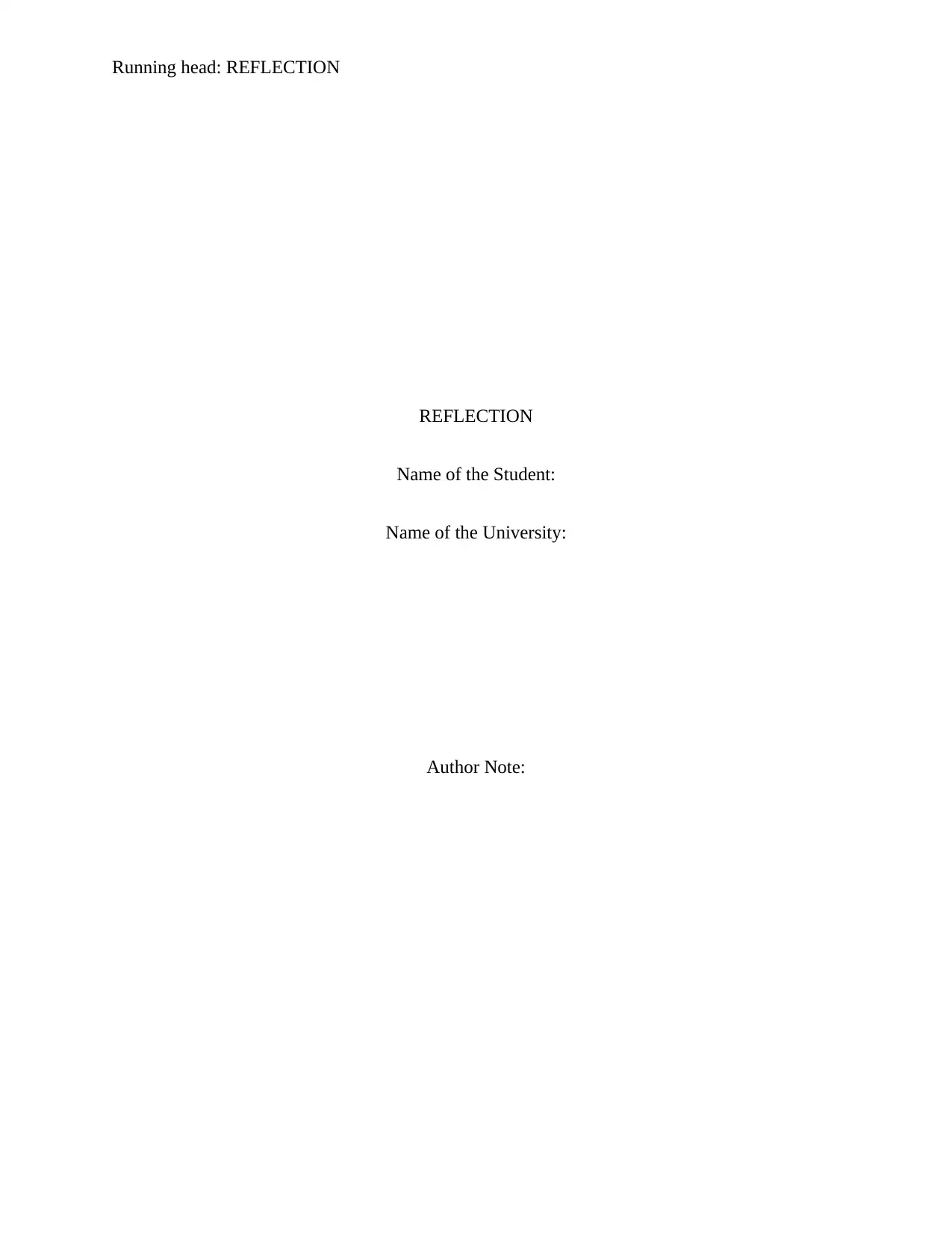
Running head: REFLECTION
REFLECTION
Name of the Student:
Name of the University:
Author Note:
REFLECTION
Name of the Student:
Name of the University:
Author Note:
Paraphrase This Document
Need a fresh take? Get an instant paraphrase of this document with our AI Paraphraser
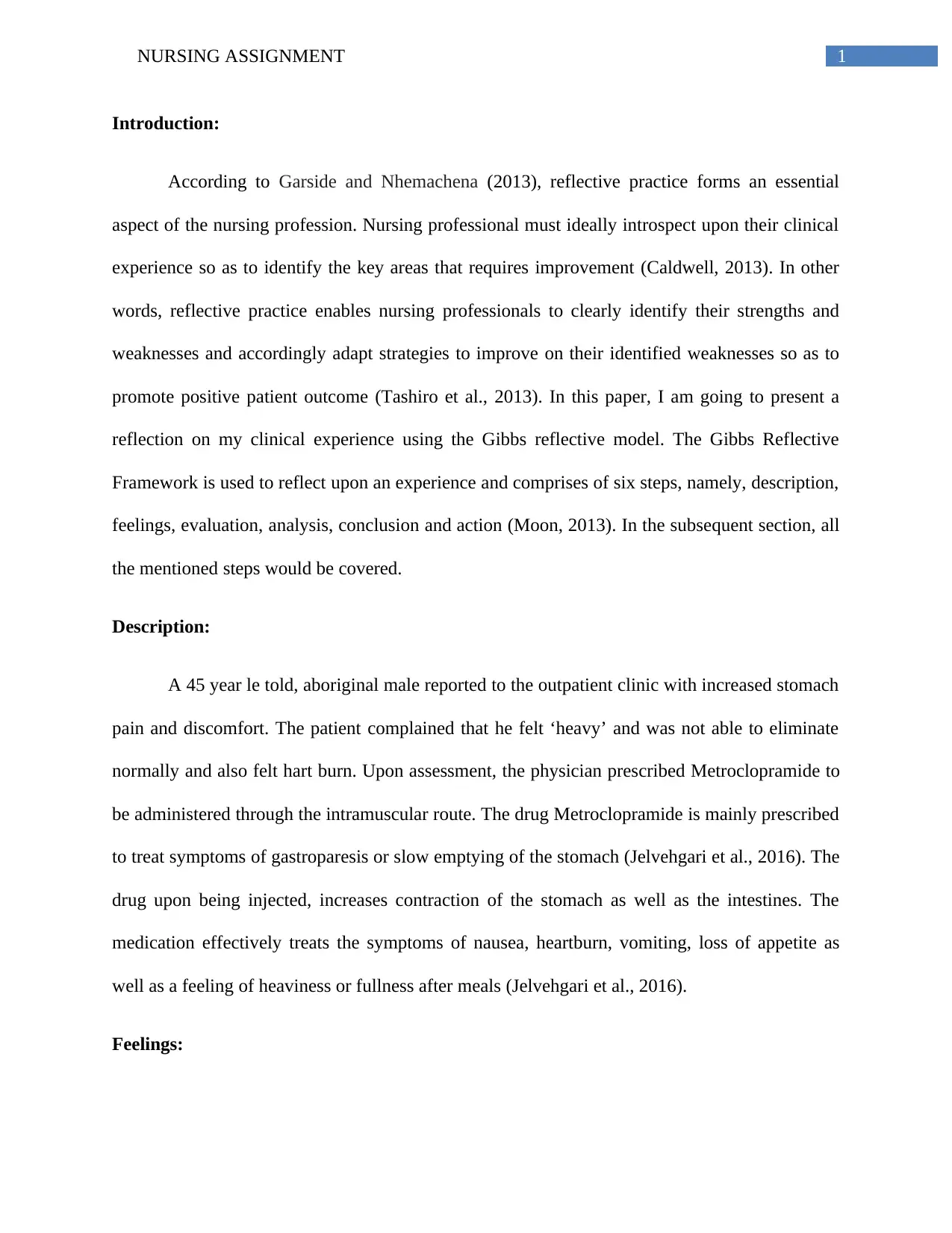
1NURSING ASSIGNMENT
Introduction:
According to Garside and Nhemachena (2013), reflective practice forms an essential
aspect of the nursing profession. Nursing professional must ideally introspect upon their clinical
experience so as to identify the key areas that requires improvement (Caldwell, 2013). In other
words, reflective practice enables nursing professionals to clearly identify their strengths and
weaknesses and accordingly adapt strategies to improve on their identified weaknesses so as to
promote positive patient outcome (Tashiro et al., 2013). In this paper, I am going to present a
reflection on my clinical experience using the Gibbs reflective model. The Gibbs Reflective
Framework is used to reflect upon an experience and comprises of six steps, namely, description,
feelings, evaluation, analysis, conclusion and action (Moon, 2013). In the subsequent section, all
the mentioned steps would be covered.
Description:
A 45 year le told, aboriginal male reported to the outpatient clinic with increased stomach
pain and discomfort. The patient complained that he felt ‘heavy’ and was not able to eliminate
normally and also felt hart burn. Upon assessment, the physician prescribed Metroclopramide to
be administered through the intramuscular route. The drug Metroclopramide is mainly prescribed
to treat symptoms of gastroparesis or slow emptying of the stomach (Jelvehgari et al., 2016). The
drug upon being injected, increases contraction of the stomach as well as the intestines. The
medication effectively treats the symptoms of nausea, heartburn, vomiting, loss of appetite as
well as a feeling of heaviness or fullness after meals (Jelvehgari et al., 2016).
Feelings:
Introduction:
According to Garside and Nhemachena (2013), reflective practice forms an essential
aspect of the nursing profession. Nursing professional must ideally introspect upon their clinical
experience so as to identify the key areas that requires improvement (Caldwell, 2013). In other
words, reflective practice enables nursing professionals to clearly identify their strengths and
weaknesses and accordingly adapt strategies to improve on their identified weaknesses so as to
promote positive patient outcome (Tashiro et al., 2013). In this paper, I am going to present a
reflection on my clinical experience using the Gibbs reflective model. The Gibbs Reflective
Framework is used to reflect upon an experience and comprises of six steps, namely, description,
feelings, evaluation, analysis, conclusion and action (Moon, 2013). In the subsequent section, all
the mentioned steps would be covered.
Description:
A 45 year le told, aboriginal male reported to the outpatient clinic with increased stomach
pain and discomfort. The patient complained that he felt ‘heavy’ and was not able to eliminate
normally and also felt hart burn. Upon assessment, the physician prescribed Metroclopramide to
be administered through the intramuscular route. The drug Metroclopramide is mainly prescribed
to treat symptoms of gastroparesis or slow emptying of the stomach (Jelvehgari et al., 2016). The
drug upon being injected, increases contraction of the stomach as well as the intestines. The
medication effectively treats the symptoms of nausea, heartburn, vomiting, loss of appetite as
well as a feeling of heaviness or fullness after meals (Jelvehgari et al., 2016).
Feelings:
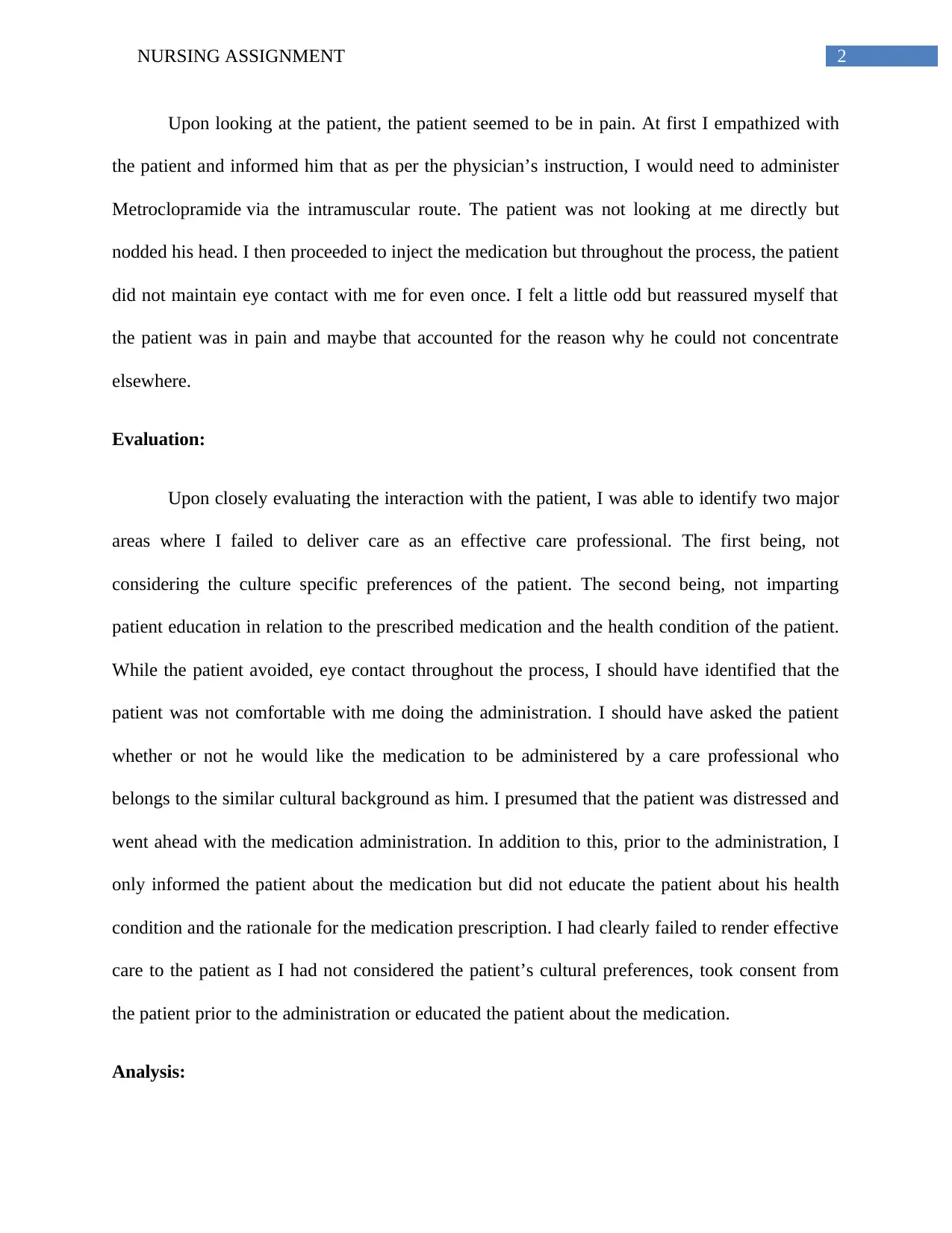
2NURSING ASSIGNMENT
Upon looking at the patient, the patient seemed to be in pain. At first I empathized with
the patient and informed him that as per the physician’s instruction, I would need to administer
Metroclopramide via the intramuscular route. The patient was not looking at me directly but
nodded his head. I then proceeded to inject the medication but throughout the process, the patient
did not maintain eye contact with me for even once. I felt a little odd but reassured myself that
the patient was in pain and maybe that accounted for the reason why he could not concentrate
elsewhere.
Evaluation:
Upon closely evaluating the interaction with the patient, I was able to identify two major
areas where I failed to deliver care as an effective care professional. The first being, not
considering the culture specific preferences of the patient. The second being, not imparting
patient education in relation to the prescribed medication and the health condition of the patient.
While the patient avoided, eye contact throughout the process, I should have identified that the
patient was not comfortable with me doing the administration. I should have asked the patient
whether or not he would like the medication to be administered by a care professional who
belongs to the similar cultural background as him. I presumed that the patient was distressed and
went ahead with the medication administration. In addition to this, prior to the administration, I
only informed the patient about the medication but did not educate the patient about his health
condition and the rationale for the medication prescription. I had clearly failed to render effective
care to the patient as I had not considered the patient’s cultural preferences, took consent from
the patient prior to the administration or educated the patient about the medication.
Analysis:
Upon looking at the patient, the patient seemed to be in pain. At first I empathized with
the patient and informed him that as per the physician’s instruction, I would need to administer
Metroclopramide via the intramuscular route. The patient was not looking at me directly but
nodded his head. I then proceeded to inject the medication but throughout the process, the patient
did not maintain eye contact with me for even once. I felt a little odd but reassured myself that
the patient was in pain and maybe that accounted for the reason why he could not concentrate
elsewhere.
Evaluation:
Upon closely evaluating the interaction with the patient, I was able to identify two major
areas where I failed to deliver care as an effective care professional. The first being, not
considering the culture specific preferences of the patient. The second being, not imparting
patient education in relation to the prescribed medication and the health condition of the patient.
While the patient avoided, eye contact throughout the process, I should have identified that the
patient was not comfortable with me doing the administration. I should have asked the patient
whether or not he would like the medication to be administered by a care professional who
belongs to the similar cultural background as him. I presumed that the patient was distressed and
went ahead with the medication administration. In addition to this, prior to the administration, I
only informed the patient about the medication but did not educate the patient about his health
condition and the rationale for the medication prescription. I had clearly failed to render effective
care to the patient as I had not considered the patient’s cultural preferences, took consent from
the patient prior to the administration or educated the patient about the medication.
Analysis:
⊘ This is a preview!⊘
Do you want full access?
Subscribe today to unlock all pages.

Trusted by 1+ million students worldwide
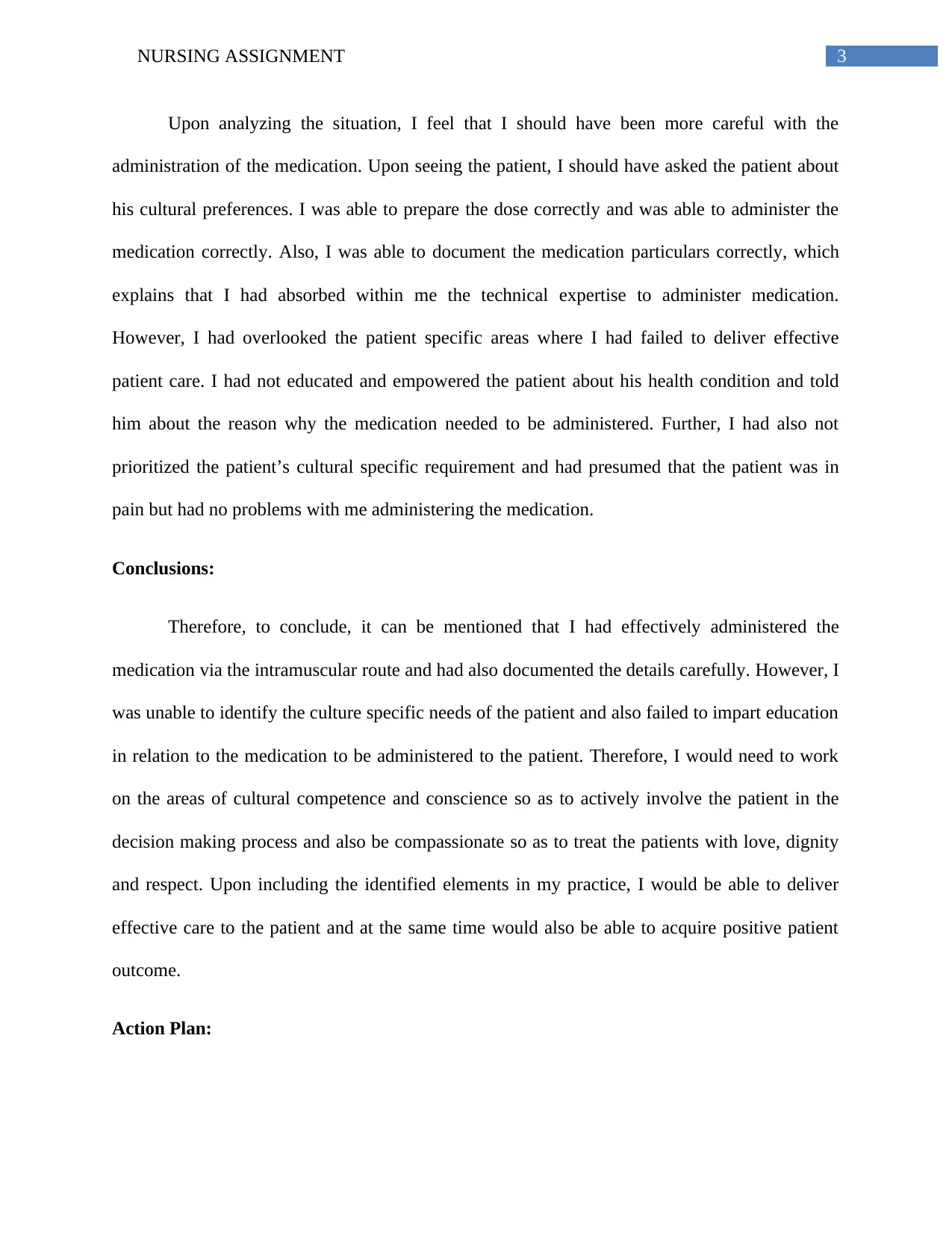
3NURSING ASSIGNMENT
Upon analyzing the situation, I feel that I should have been more careful with the
administration of the medication. Upon seeing the patient, I should have asked the patient about
his cultural preferences. I was able to prepare the dose correctly and was able to administer the
medication correctly. Also, I was able to document the medication particulars correctly, which
explains that I had absorbed within me the technical expertise to administer medication.
However, I had overlooked the patient specific areas where I had failed to deliver effective
patient care. I had not educated and empowered the patient about his health condition and told
him about the reason why the medication needed to be administered. Further, I had also not
prioritized the patient’s cultural specific requirement and had presumed that the patient was in
pain but had no problems with me administering the medication.
Conclusions:
Therefore, to conclude, it can be mentioned that I had effectively administered the
medication via the intramuscular route and had also documented the details carefully. However, I
was unable to identify the culture specific needs of the patient and also failed to impart education
in relation to the medication to be administered to the patient. Therefore, I would need to work
on the areas of cultural competence and conscience so as to actively involve the patient in the
decision making process and also be compassionate so as to treat the patients with love, dignity
and respect. Upon including the identified elements in my practice, I would be able to deliver
effective care to the patient and at the same time would also be able to acquire positive patient
outcome.
Action Plan:
Upon analyzing the situation, I feel that I should have been more careful with the
administration of the medication. Upon seeing the patient, I should have asked the patient about
his cultural preferences. I was able to prepare the dose correctly and was able to administer the
medication correctly. Also, I was able to document the medication particulars correctly, which
explains that I had absorbed within me the technical expertise to administer medication.
However, I had overlooked the patient specific areas where I had failed to deliver effective
patient care. I had not educated and empowered the patient about his health condition and told
him about the reason why the medication needed to be administered. Further, I had also not
prioritized the patient’s cultural specific requirement and had presumed that the patient was in
pain but had no problems with me administering the medication.
Conclusions:
Therefore, to conclude, it can be mentioned that I had effectively administered the
medication via the intramuscular route and had also documented the details carefully. However, I
was unable to identify the culture specific needs of the patient and also failed to impart education
in relation to the medication to be administered to the patient. Therefore, I would need to work
on the areas of cultural competence and conscience so as to actively involve the patient in the
decision making process and also be compassionate so as to treat the patients with love, dignity
and respect. Upon including the identified elements in my practice, I would be able to deliver
effective care to the patient and at the same time would also be able to acquire positive patient
outcome.
Action Plan:
Paraphrase This Document
Need a fresh take? Get an instant paraphrase of this document with our AI Paraphraser
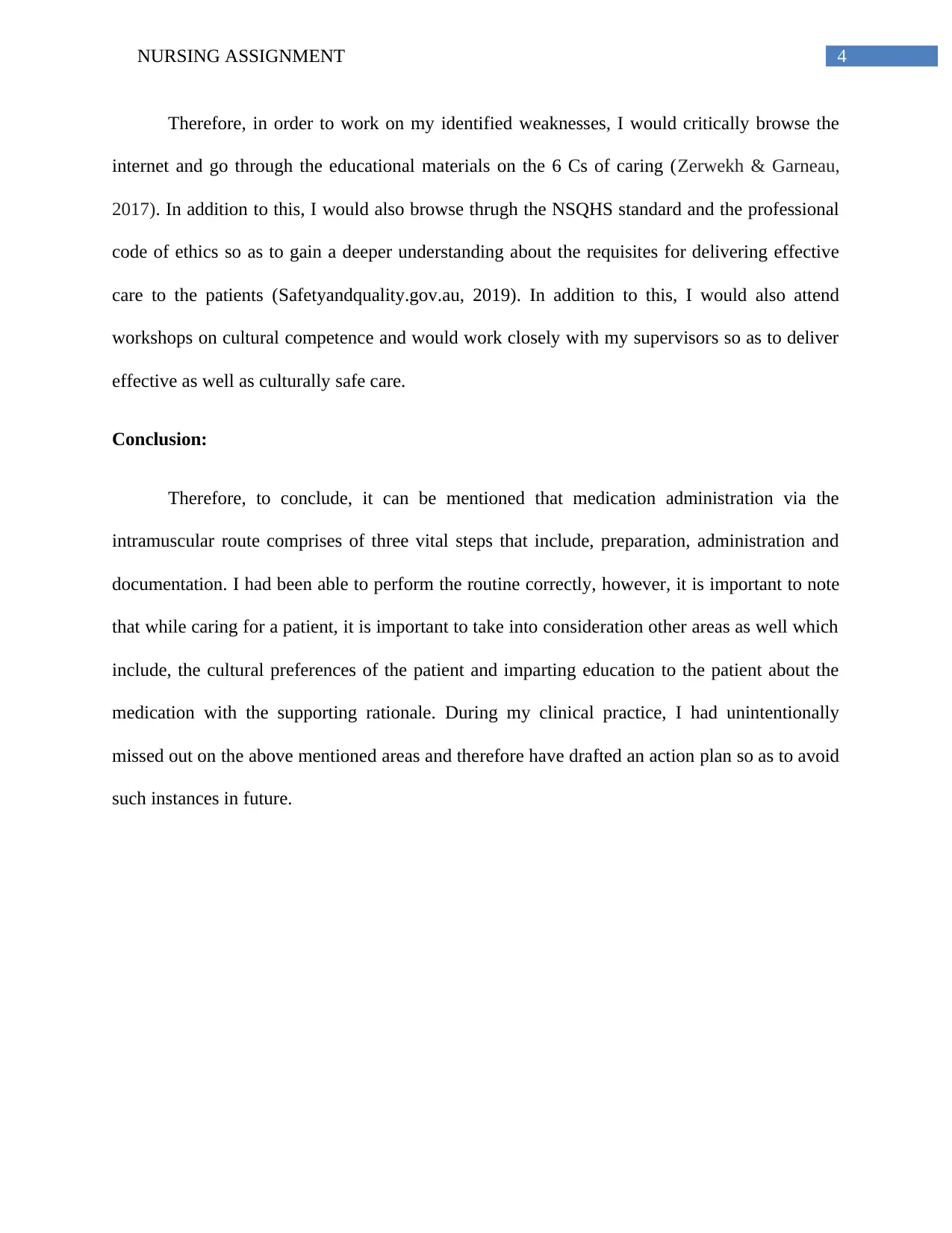
4NURSING ASSIGNMENT
Therefore, in order to work on my identified weaknesses, I would critically browse the
internet and go through the educational materials on the 6 Cs of caring (Zerwekh & Garneau,
2017). In addition to this, I would also browse thrugh the NSQHS standard and the professional
code of ethics so as to gain a deeper understanding about the requisites for delivering effective
care to the patients (Safetyandquality.gov.au, 2019). In addition to this, I would also attend
workshops on cultural competence and would work closely with my supervisors so as to deliver
effective as well as culturally safe care.
Conclusion:
Therefore, to conclude, it can be mentioned that medication administration via the
intramuscular route comprises of three vital steps that include, preparation, administration and
documentation. I had been able to perform the routine correctly, however, it is important to note
that while caring for a patient, it is important to take into consideration other areas as well which
include, the cultural preferences of the patient and imparting education to the patient about the
medication with the supporting rationale. During my clinical practice, I had unintentionally
missed out on the above mentioned areas and therefore have drafted an action plan so as to avoid
such instances in future.
Therefore, in order to work on my identified weaknesses, I would critically browse the
internet and go through the educational materials on the 6 Cs of caring (Zerwekh & Garneau,
2017). In addition to this, I would also browse thrugh the NSQHS standard and the professional
code of ethics so as to gain a deeper understanding about the requisites for delivering effective
care to the patients (Safetyandquality.gov.au, 2019). In addition to this, I would also attend
workshops on cultural competence and would work closely with my supervisors so as to deliver
effective as well as culturally safe care.
Conclusion:
Therefore, to conclude, it can be mentioned that medication administration via the
intramuscular route comprises of three vital steps that include, preparation, administration and
documentation. I had been able to perform the routine correctly, however, it is important to note
that while caring for a patient, it is important to take into consideration other areas as well which
include, the cultural preferences of the patient and imparting education to the patient about the
medication with the supporting rationale. During my clinical practice, I had unintentionally
missed out on the above mentioned areas and therefore have drafted an action plan so as to avoid
such instances in future.
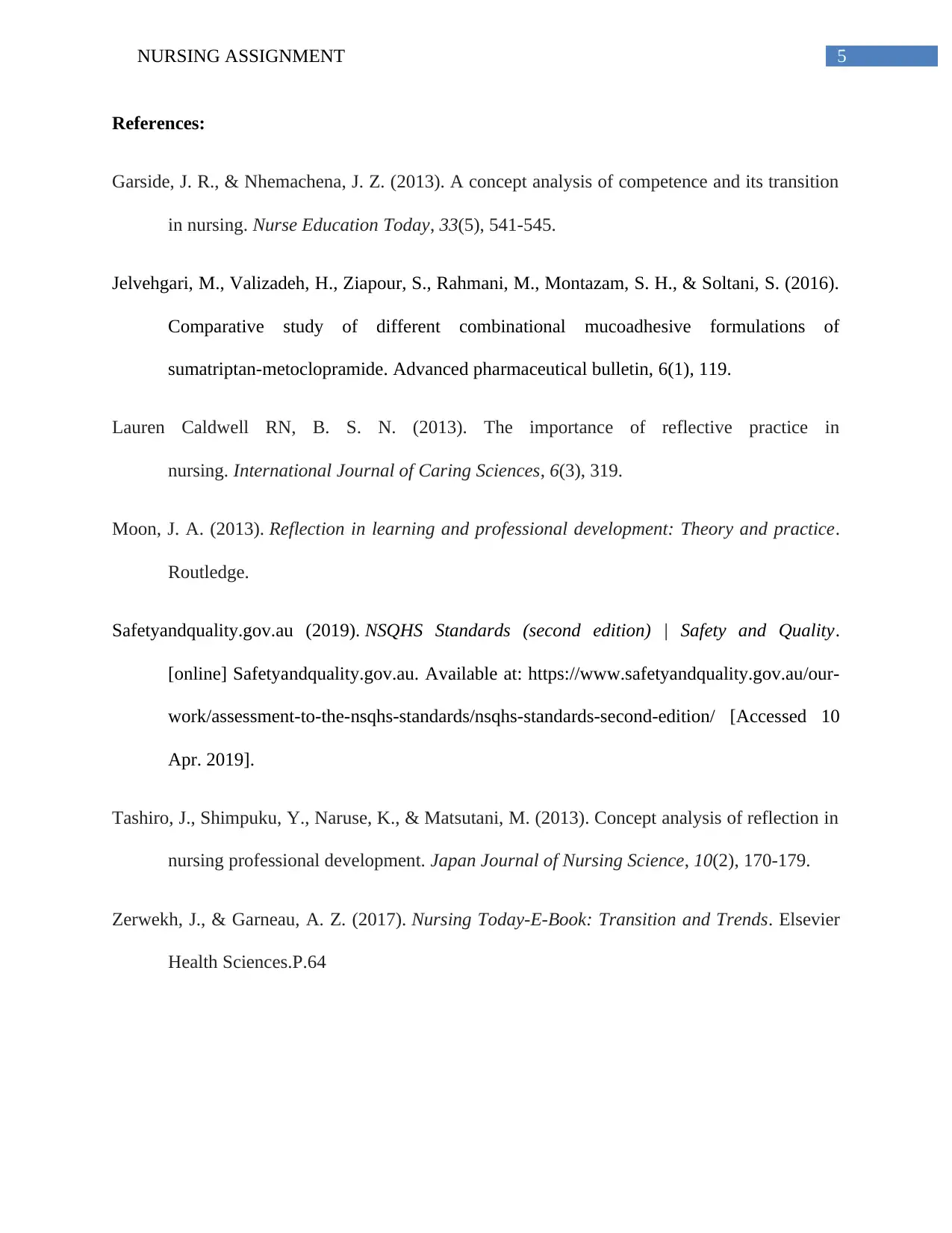
5NURSING ASSIGNMENT
References:
Garside, J. R., & Nhemachena, J. Z. (2013). A concept analysis of competence and its transition
in nursing. Nurse Education Today, 33(5), 541-545.
Jelvehgari, M., Valizadeh, H., Ziapour, S., Rahmani, M., Montazam, S. H., & Soltani, S. (2016).
Comparative study of different combinational mucoadhesive formulations of
sumatriptan-metoclopramide. Advanced pharmaceutical bulletin, 6(1), 119.
Lauren Caldwell RN, B. S. N. (2013). The importance of reflective practice in
nursing. International Journal of Caring Sciences, 6(3), 319.
Moon, J. A. (2013). Reflection in learning and professional development: Theory and practice.
Routledge.
Safetyandquality.gov.au (2019). NSQHS Standards (second edition) | Safety and Quality.
[online] Safetyandquality.gov.au. Available at: https://www.safetyandquality.gov.au/our-
work/assessment-to-the-nsqhs-standards/nsqhs-standards-second-edition/ [Accessed 10
Apr. 2019].
Tashiro, J., Shimpuku, Y., Naruse, K., & Matsutani, M. (2013). Concept analysis of reflection in
nursing professional development. Japan Journal of Nursing Science, 10(2), 170-179.
Zerwekh, J., & Garneau, A. Z. (2017). Nursing Today-E-Book: Transition and Trends. Elsevier
Health Sciences.P.64
References:
Garside, J. R., & Nhemachena, J. Z. (2013). A concept analysis of competence and its transition
in nursing. Nurse Education Today, 33(5), 541-545.
Jelvehgari, M., Valizadeh, H., Ziapour, S., Rahmani, M., Montazam, S. H., & Soltani, S. (2016).
Comparative study of different combinational mucoadhesive formulations of
sumatriptan-metoclopramide. Advanced pharmaceutical bulletin, 6(1), 119.
Lauren Caldwell RN, B. S. N. (2013). The importance of reflective practice in
nursing. International Journal of Caring Sciences, 6(3), 319.
Moon, J. A. (2013). Reflection in learning and professional development: Theory and practice.
Routledge.
Safetyandquality.gov.au (2019). NSQHS Standards (second edition) | Safety and Quality.
[online] Safetyandquality.gov.au. Available at: https://www.safetyandquality.gov.au/our-
work/assessment-to-the-nsqhs-standards/nsqhs-standards-second-edition/ [Accessed 10
Apr. 2019].
Tashiro, J., Shimpuku, Y., Naruse, K., & Matsutani, M. (2013). Concept analysis of reflection in
nursing professional development. Japan Journal of Nursing Science, 10(2), 170-179.
Zerwekh, J., & Garneau, A. Z. (2017). Nursing Today-E-Book: Transition and Trends. Elsevier
Health Sciences.P.64
⊘ This is a preview!⊘
Do you want full access?
Subscribe today to unlock all pages.

Trusted by 1+ million students worldwide
1 out of 6
Related Documents
Your All-in-One AI-Powered Toolkit for Academic Success.
+13062052269
info@desklib.com
Available 24*7 on WhatsApp / Email
![[object Object]](/_next/static/media/star-bottom.7253800d.svg)
Unlock your academic potential
Copyright © 2020–2025 A2Z Services. All Rights Reserved. Developed and managed by ZUCOL.





